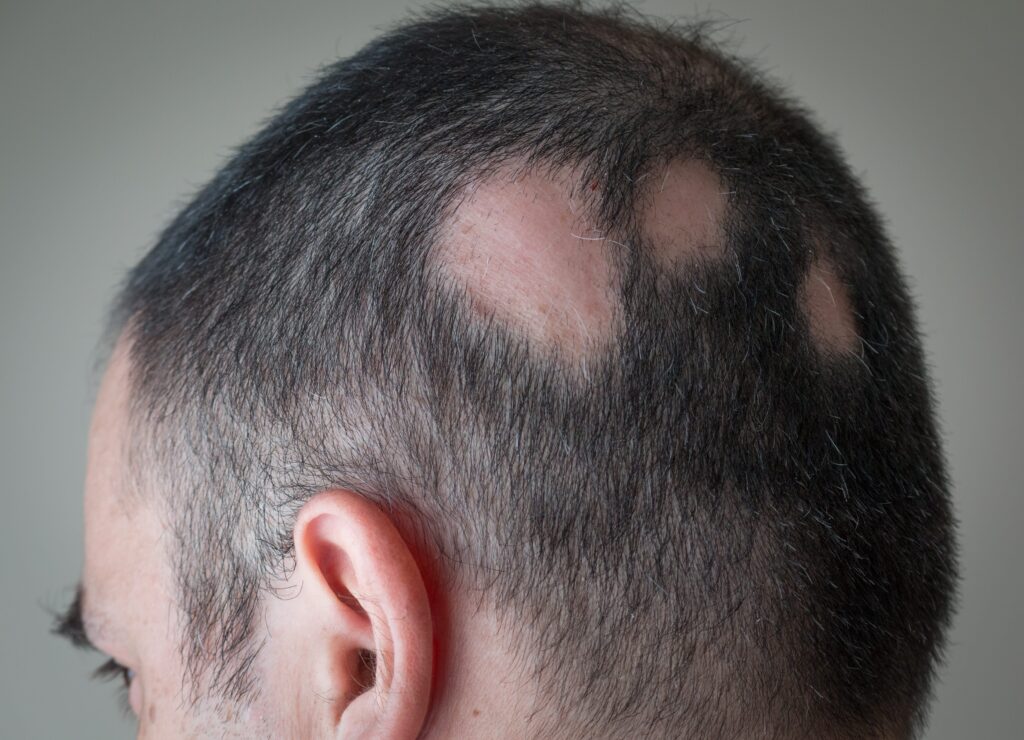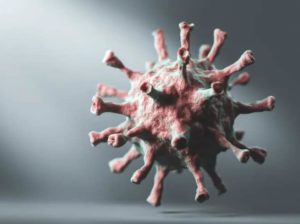Alopecia areata affects millions of people, causing their hair to fall out in circular patches. It is one of the most common types of hair loss, exceeded only in frequency by genetic hair loss.
The onset is usually sudden. One day everything is normal. Then almost overnight the hair falls out and round bald patches appear on the head or other areas of the body.
The risk factors which cause people to develop alopecia areata have not yet been precisely clarified by doctors. In fact, to this day, this disease poses a great mystery.
Many people with alopecia areata find that suffering from it is a traumatising or shocking event. One of the main reason is because it is so sudden.
What is the main cause of alopecia areata?

Researchers have yet to fully understand the exact cause of alopecia areata. However, they believe alopecia areata is an autoimmune disease. This means that the body’s immune system mistakenly attacks the hair follicles, leading to hair loss.
Researchers believe several factors contribute to the development of alopecia areata:
- Genetic factors: Alopecia areata tends to run in families, suggesting a genetic predisposition depending on the family history. Individuals with family members suffering of the condition may be at a higher risk of developing it.
- Autoimmune response: It is believed that an abnormal immune response triggers an attack on hair follicles. The immune system mistakenly identifies hair follicles as foreign invaders and attacks them, leading to hair loss.
- Environmental factors: Certain environmental factors may act as triggers in individuals who are genetically susceptible to this condition. These factors may include viral or bacterial infections, physical or emotional stress. They also include hormonal imbalances, or trauma to the skin, as well as, according to one study, certain lifestyle factors.
- Other autoimmune conditions: According to another study, people with other autoimmune disorders, such as thyroid disease, rheumatoid arthritis, or vitiligo, have a higher risk of developing alopecia areata.
- Psychological factors: Emotional and psychological stress may play a role in triggering or exacerbating alopecia areata in some individuals. However, it is important to note that stress alone is not the sole cause of the condition.
It is important to remember that while these factors may contribute to the development of alopecia areata, the condition can occur without any identifiable triggers. If you experience hair loss or have concerns about alopecia areata, consult a dermatologist or healthcare professional for an accurate diagnosis and appropriate management.
What are the different types of alopecia areata and their symptoms?
There are quite a few different types and patterns of hair loss associated with this condition. The symptoms of alopecia areata can vary from person to person. However, there are some common signs to look out for. Here are the 5 most common types and their symptoms in descending order:
- Patchy alopecia areata: This is the most common type of alopecia areata. It is characterized by the development of oval-shaped, coin sized patches of hair loss. They can either be on the scalp or other areas of the body. The patches can be small or larger and may merge together.
- Alopecia totalis: In this type, as the latin name suggests, there is complete loss of hair on the scalp.
- Alopecia universalis: This is the most severe form of alopecia areata. It characterizes by the complete loss of hair on the scalp and body. It includes the loss of eyebrows, eyelashes, facial hair, and body hair. This type of alopecia can have a significant impact on a person’s appearance.
- Diffuse alopecia areata: Unlike the patchy pattern, diffuse alopecia areata involves more widespread and scattered hair loss without distinct patches. Hair loss occurs across the scalp rather than in well-defined areas.
- Alopecia areata ophiasis: Ophiasis is a specific pattern of hair loss where hair loss occurs in a band-like shape along the sides and lower back of the scalp. The name “ophiasis” is derived from the Greek word for “snake” because the hair loss pattern resembles a snake wrapping around the head.
What are the treatment options for alopecia areata?

Currently, there is no known definitve cure for this condition. However, there are various treatment options available that can help manage the condition and stimulate hair regrowth.
- Medications: Doctors commonly prescribe anti-inflammatory drugs, such as topical corticosteroids, to reduce inflammation and suppress the immune response in affected areas. They also use Minoxidil, a medication typically for androgenetic alopecia, to effectively treat alopecia areata and promote hair growth in some cases.
- Injections: Doctors can administer intralesional steroid injections directly into the bald patches to stimulate hair regrowth. They often recommend this treatment for more extensive cases of alopecia areata.
- Topical immunotherapy: A treatment known as contact immunotherapy involves applying a sensitizing substance, such as diphencyprone (DPCP), to the scalp. This triggers an allergic reaction that can stimulate hair regrowth and has been shown to be effective and safe.
- Light therapy: Doctors use excimer laser and ultraviolet (UV) light treatments to stimulate hair regrowth by targeting the affected areas of the scalp.
- Supportive measures: In addition to medical treatments, some people find it helpful to use cosmetic techniques, such as wigs, hairpieces, or scalp micropigmentation, to manage the appearance of hair loss.
You should consult with a dermatologist or healthcare professional to determine the most suitable treatment approach based on individual circumstances and the extent of hair loss. Please remember that managing alopecia areata requires a personalised approach, and it’s important to have realistic expectations about the potential for hair regrowth.
Can you get a hair transplant if you suffer from it?
In principle, hair transplantation is possible for alopecia areata. This is particularly the case when the hair grows back no longer in its former density and remains visibly thin in the affected areas.
However, it is very important that the alopecia areata is completely healed. Otherwise, there is a risk that the immune system will attack the freshly transplanted follicles, making them immediately fall out again.
The attending physician will examine the bald area closely to make sure that there is no risk of the transplanted hair follicles being attacked again by the immune system.
A reputable hair transplant clinic will never pressure you into a hair transplant. In cases of alopecia areata a hair transplant in Turkey can have good before and after hair transplant results, but is only suitable in certain circumstances. In the wrong circumstances, it can do more harm than good.
If you have any further questions, please do not hesitate to contact us. The professional team of experts at Cosmedica Clinic will be happy to answer all your questions about hair transplantation for circular hair loss and regrowth.




